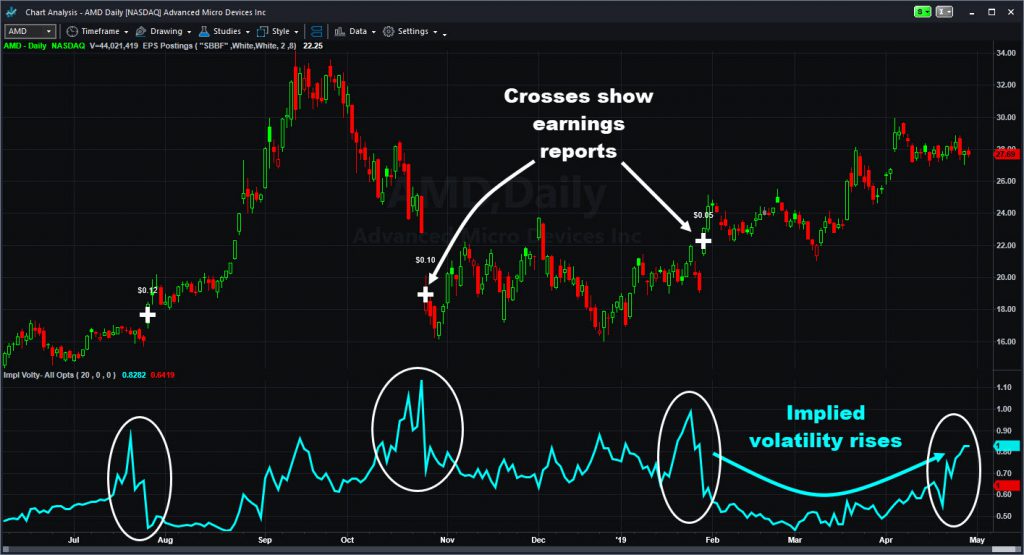One of the most predictable trends in the market is that implied volatility rises before big events. But do you know what this means and how to trade it? Here are the basics.
Options price in the likelihood of a stock moving, either higher or lower. They get more expensive when a major catalyst approaches, like quarterly earnings.
Advanced Micro Devices (AMD), one of TradeStation’s most active symbols, is a case in point right now.
The chip maker’s “implied volatility” has risen from 48 percent in early March to over 80 percent on Monday. That means the cost of options on AMD has almost doubled, moving in the opposite direction of the broader market over the same period.
Tonight’s earnings report is the reason. AMD has experienced some huge moves in the last year after announcing quarterly results:
- AMD ripped 14 percent last July after strong demand for its Epyc data-center chips pushed earnings past consensus estimates.
- AMD crashed 16 percent last October on weak revenue guidance.
- AMD surged 20 percent in late January as data-center demand continued to grow
As the chart shows, implied volatility rose into each of those reports and then fell after. The same pattern is playing out now.

How to Play It
Options traders have developed strategies to profit from this highly predictable rise and fall of implied volatility.
One basic method is to sell calls and puts at the same time. Only one of them can go against you after the event because they make money in opposite directions. This kind of trade is known is either a strangle or straddle. (Our Knowledge Center has more resources on both.)
Still, trades like that can be highly risky if the underlying security moves too far in either direction. You can lose a lot more money than you might have in your account, so most people need to avoid them.
Safer versions of both are the condor and iron butterfly. These add long calls and puts at further price points as hedges against big moves. Cost goes up as a result, lowering your potential profit. Less risk means less reward. Not a surprise!
Covered Calls & Diagonal Spreads
Those four strategies are entirely neutral. They simply want AMD to move as little as possible. And, they perform similarly to the upside and the downside.
But say you’re bullish on the company and still want to make money from the implied volatility dropping after the report. In that case you may want to consider a covered call or a diagonal spread.
With a covered call, the trader owns shares and sells calls against them. That lets him or her collect premium but creates an obligation to relinquish their stock if it rallies too much. They also have downside risk if the AMD drops a lot. (Fortunately for them, the calls they shorted will lose also value.)
A diagonal spread entails buying one call “next week” at a lower strike price and selling another call “this week” at a higher strike. The shorter dated contracts will lose value more quickly, while the longer dated ones can appreciate in the event of a rally. This technique was outlined with Apple (AAPL) last summer.
In conclusion, the link between implied volatility and event risk is one of the the most basic principles in the options market. Earnings season often brings potential opportunities to profit from the trend. Hopefully this post helps you understand the process.






















